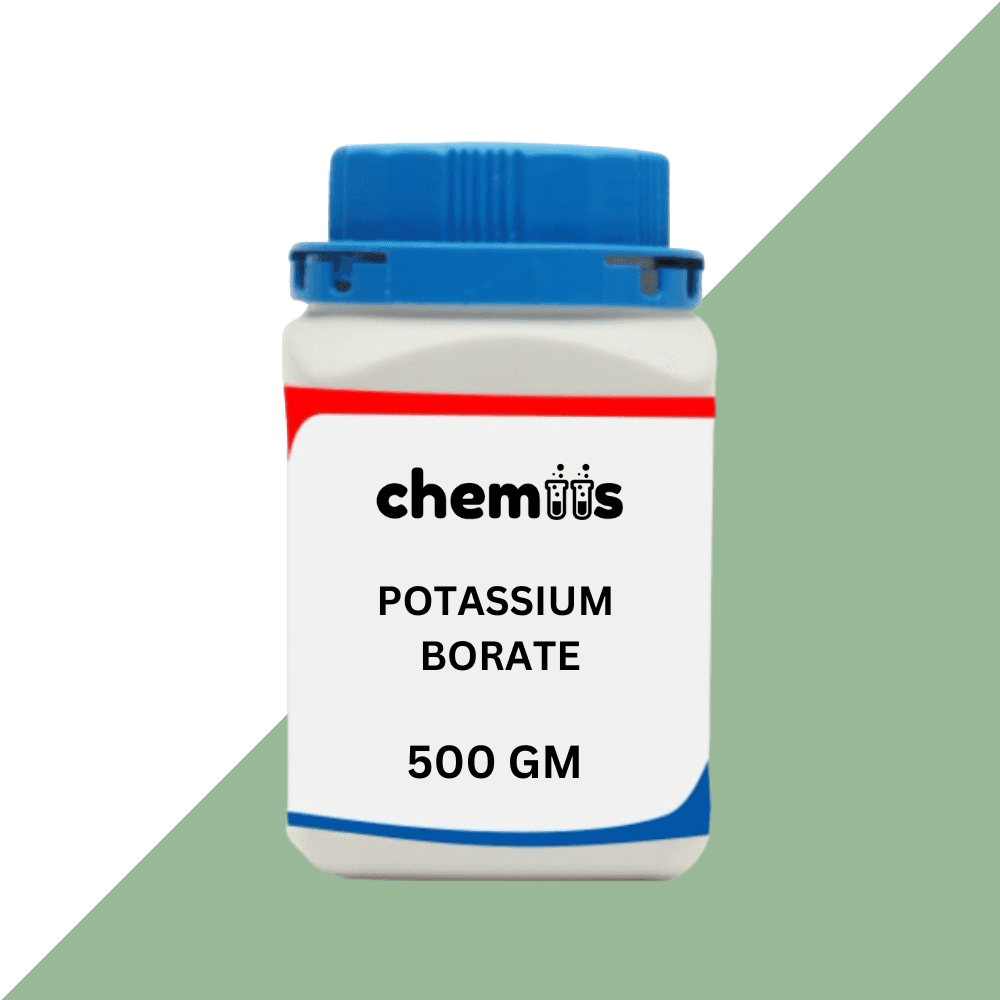Potassium Borate is a white crystalline inorganic compound composed of potassium (K), boron (B), and oxygen (O). It is often used as a source of both potassium and boron, two essential nutrients for plants, making it an important compound in agriculture. Potassium Borate finds its primary applications in glass manufacturing, ceramics, agriculture (as a fertilizer), and in chemical synthesis. It acts as a flux in glass production and a stabilizer for certain chemical reactions, while its role in agriculture helps improve soil health and boost crop yield. Additionally, it is utilized in fire retardants and as a pH buffer in various formulations
Applications
1. Agricultural Use (Fertilizer)
Potassium Borate is commonly used as a fertilizer to provide essential potassium and boron to plants. Boron is a vital micronutrient that helps with cell wall formation, reproductive growth, and the development of seeds and fruits. Potassium, on the other hand, is crucial for water regulation, enzyme activation, and overall plant health. Potassium Borate is often applied to crops such as fruits, vegetables, and legumes to improve growth and yield.
Uses:
- Fertilizer for plants
- Essential for healthy crop development
- Improves seed and fruit development
Benefits:
- Boosts plant growth and productivity
- Enhances resistance to disease
- Improves the quality and quantity of yields
2. Glass Manufacturing
In the glass industry, Potassium Borate is used as a flux, helping to lower the melting point of raw materials and enhance the efficiency of glass production. It is especially useful in the production of borosilicate glass, which is known for its high resistance to thermal shock and chemical stability. Potassium Borate also helps to improve the durability and clarity of the glass, making it suitable for laboratory equipment, cookware, and industrial applications.
Uses:
- Flux in glass manufacturing
- Production of borosilicate glass
- Improves glass durability and clarity
Benefits:
- Lowers melting point of raw materials
- Enhances glass properties such as thermal shock resistance
- Increases efficiency in glass production processes
3. Chemical Synthesis
Potassium Borate is utilized as a reagent in chemical reactions and as a stabilizer in some industrial processes. It is often used in the production of chemicals, where it acts as a catalyst or a stabilizing agent to maintain the desired reaction conditions. It is also used in the synthesis of other boron compounds.
Uses:
- Chemical reagent in synthesis
- Stabilizer for chemical reactions
- Production of other boron compounds
Benefits:
- Facilitates chemical reactions
- Ensures stability during chemical synthesis
- Useful in the production of advanced materials and chemicals
4. pH Buffering
Due to its alkaline nature, Potassium Borate is used as a pH buffer in a variety of applications, including cosmetics, pharmaceuticals, and cleaning products. It helps maintain a stable pH in products, preventing them from becoming too acidic or alkaline. This is particularly important in formulations where a specific pH level is required for the efficacy or safety of the product.
Uses:
- pH buffer in various formulations
- Used in cosmetics, cleaning agents, and pharmaceuticals
- Helps maintain product stability
Benefits:
- Stabilizes pH levels in formulations
- Improves product effectiveness and safety
- Essential in products that require a precise pH balance
5. Fire Retardants
Potassium Borate is also used in the production of fire retardants. It is incorporated into materials such as textiles, wood, and insulation to enhance their resistance to fire. The compound works by releasing boron during combustion, which helps to form a protective barrier and reduce the flammability of materials.
Uses:
- Fire retardant in textiles, wood, and insulation materials
- Enhances fire resistance in various products
Benefits:
- Reduces flammability of materials
- Enhances fire safety in textiles and building materials
- Extends the lifespan of materials by preventing fire damage
Safety and Handling
Safety Precautions
While Potassium Borate is generally safe to handle, it is important to observe proper safety guidelines to prevent exposure to its dust or concentrated forms.
- Personal Protective Equipment (PPE): Wear gloves, goggles, and protective clothing when handling Potassium Borate. If handling in large quantities or in dusty environments, a dust mask may be necessary.
- Ventilation: Ensure good ventilation in the area where Potassium Borate is being used to avoid inhalation of dust.
- Storage: Store in a cool, dry place, away from moisture and incompatible substances. Keep containers tightly closed and label them appropriately.
First Aid Measures
- Skin Contact: Wash the affected area with soap and water. If irritation persists, seek medical attention.
- Eye Contact: Rinse immediately with plenty of water for at least 15 minutes. Seek medical attention if irritation continues.
- Inhalation: Move to fresh air immediately. If symptoms persist or breathing difficulty occurs, seek medical attention.
- Ingestion: If swallowed, rinse mouth with water and drink a small amount of water. Seek medical attention if large amounts have been ingested.
Environmental Considerations
Potassium Borate is considered relatively safe for the environment when used properly. However, large quantities should not be released into natural water bodies as it could potentially affect aquatic life. Always dispose of the product according to local environmental regulations to minimize any impact.


















Reviews
Clear filtersThere are no reviews yet.